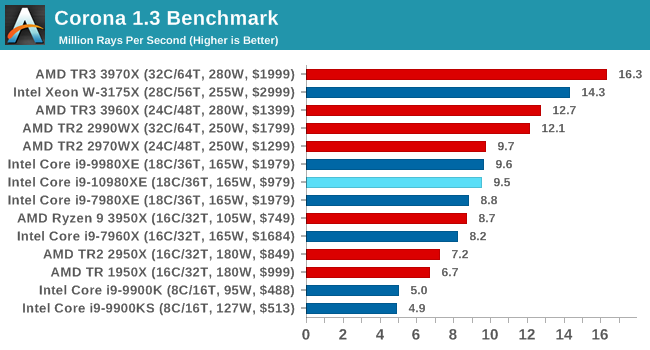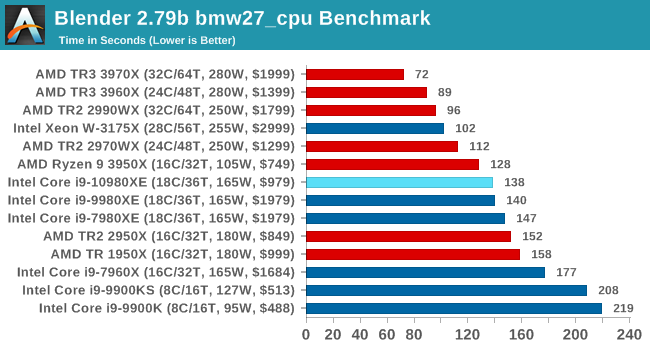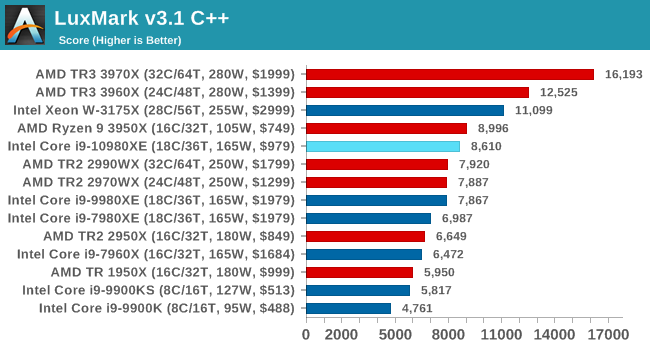It’s a Cascade of 14nm CPUs: AnandTech’s Intel Core i9-10980XE Review
by Dr. Ian Cutress on November 25, 2019 9:00 AM ESTCPU Performance: Rendering Tests
Rendering is often a key target for processor workloads, lending itself to a professional environment. It comes in different formats as well, from 3D rendering through rasterization, such as games, or by ray tracing, and invokes the ability of the software to manage meshes, textures, collisions, aliasing, physics (in animations), and discarding unnecessary work. Most renderers offer CPU code paths, while a few use GPUs and select environments use FPGAs or dedicated ASICs. For big studios however, CPUs are still the hardware of choice.
All of our benchmark results can also be found in our benchmark engine, Bench.
Corona 1.3: Performance Render
An advanced performance based renderer for software such as 3ds Max and Cinema 4D, the Corona benchmark renders a generated scene as a standard under its 1.3 software version. Normally the GUI implementation of the benchmark shows the scene being built, and allows the user to upload the result as a ‘time to complete’.
We got in contact with the developer who gave us a command line version of the benchmark that does a direct output of results. Rather than reporting time, we report the average number of rays per second across six runs, as the performance scaling of a result per unit time is typically visually easier to understand.
The Corona benchmark website can be found at https://corona-renderer.com/benchmark

The 10980XE sits on par with the 9980XE, but no real difference in performance.
Blender 2.79b: 3D Creation Suite
A high profile rendering tool, Blender is open-source allowing for massive amounts of configurability, and is used by a number of high-profile animation studios worldwide. The organization recently released a Blender benchmark package, a couple of weeks after we had narrowed our Blender test for our new suite, however their test can take over an hour. For our results, we run one of the sub-tests in that suite through the command line - a standard ‘bmw27’ scene in CPU only mode, and measure the time to complete the render.
Blender can be downloaded at https://www.blender.org/download/

Again, pretty much on par with the 9980XE.
LuxMark v3.1: LuxRender via Different Code Paths
As stated at the top, there are many different ways to process rendering data: CPU, GPU, Accelerator, and others. On top of that, there are many frameworks and APIs in which to program, depending on how the software will be used. LuxMark, a benchmark developed using the LuxRender engine, offers several different scenes and APIs.
In our test, we run the simple ‘Ball’ scene. This scene starts with a rough render and slowly improves the quality over two minutes, giving a final result in what is essentially an average ‘kilorays per second’.

We see a small uplift here compared to the 9980XE, but the 10980XE still sits behind the 3950X.
POV-Ray 3.7.1: Ray Tracing
The Persistence of Vision ray tracing engine is another well-known benchmarking tool, which was in a state of relative hibernation until AMD released its Zen processors, to which suddenly both Intel and AMD were submitting code to the main branch of the open source project. For our test, we use the built-in benchmark for all-cores, called from the command line.
POV-Ray can be downloaded from http://www.povray.org/

Another parity between the 10980XE and the 9980XE.











79 Comments
View All Comments
Korguz - Thursday, November 28, 2019 - link
yep.. i knew gondalf wouldnt answer my question...0ldman79 - Thursday, December 5, 2019 - link
That is ignorant.Adding L3 cannot increase processing. The L3 can only improve feeding of data, further the L3 is a victim cache, the data has to be expelled from the L2 first.
It doesn't matter how big the fuel line is on your 4 cylinder, it's only going to burn so much gas. Same for the L2 and L3. If the size of the cache increases the IPC that is *only* because the cache was too small for the design in the first place.
Korguz - Sunday, December 8, 2019 - link
keep in mind, the comment is from gondalf, he will say any thing to make his beloved intel look better, as you can see, he DIDN'T answer my question to him as well...airdrifting - Monday, November 25, 2019 - link
You are delusional. 2011 is the year for 2500K/2600K release, and since then Intel has been charging 300+ for quad core till 2017 Ryzen release. It was also the six darkest years in CPU history where we see like 5% increase in IPC every year, I kept my 4.5GHz overclocked 2600K for 6 years because there was no reason to upgrade.eek2121 - Monday, November 25, 2019 - link
Yeah that was part of the issue. Sandy Bridge had so much overclocking headroom, you could put a good AiO on it, crank it up to 4.8-5.0 GHz, and generations later the competition would just barely catch up. The percentage of difference between the two was very small, and Bulldozer was chasing Core i3s.rahvin - Monday, November 25, 2019 - link
You're not alone buddy. I've held on to my Icy Bridge 3700K until Ryzen 39**X because Intel was offering no innnovation to the market.I distinctly remember the Anandtech article for IIRC the Kaby Lake Intel processors where they basically said this was the first generation to be 20% better than Sandy Bridge/Icy Bridge which made is worth upgrading. That was 6 years without any performance increases.
Make no mistake, without AMD competition we wouldn't have moved beyond 8 cores on the desktop or 12 cores in the HEDT. Intel was happy to sit on their fingers and rake in the money with 2-5% improvement per year. In fact 3 solid years of AMD competition have doubled core counts on both the desktop and server and at the same time lowered prices across the board. Without AMD there is no innovation at Intel because they don't have competition. Thank god for Lisa Su.
Santoval - Monday, November 25, 2019 - link
Bollocks. Pulling arbitrary dollar values of nameless CPUs out of your behinds and linking even more arbitrarily 2011 CPUs to 2019 CPUs is an extremely poor tactic. Your suck at this (-->Intel apologetics). Be better so we can have meaningful arguments :)milkywayer - Monday, November 25, 2019 - link
Read the article your posting spam at. The author mentions the 1900 and 900 numbers. I'll let you guess which page. You might actual read the review then.milkywayer - Monday, November 25, 2019 - link
Whups. Meant it for RegsEx.milkywayer - Monday, November 25, 2019 - link
Out of the kindness of their heart. How generous and kind of them./s